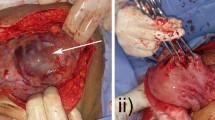Abstract
Excessive and uncontrolled hemorrhage is the main cause of morbidity and mortality in placenta accreta spectrum (PAS) disorders. We present the role of combined abdominopelvic packing as a lifesaving approach for such morbid situation. This case series describes the retrospectively analyzed outcome of 4 women with placenta accreta spectrum (PAS) who underwent packing in view of intractable oozing from vault and adjacent areas even after cesarean hysterectomy. Three to four roller gauzes were used, and removal was done 48 h later through abdominal exit sites of gauze. The 4 patients underwent cesarean hysterectomy between 32 and 34 weeks of gestation. Prophylactic uterine artery catheterization with inflation of balloon was done in all the patients. Bladder was injured during separation in two cases (50%) with Grade 3b PAS. Massive bleeding was encountered and despite cesarean hysterectomy, bleeding from the vault and surrounding areas continued. Mean blood loss was 2525 ml. Immediate repair of bladder rent was done after cesarean hysterectomy in the two cases with bladder injury. When all attempts to stop bleeding failed, abdominopelvic packing was done using three to four 200-cm roller gauzes. Relaparotomy for pack removal and otherwise, and mortality due to excessive hemorrhage was avoided. None of the patients had any long-term complication related to the procedure. Combined abdominopelvic packing can achieve acceptable results in the patients with severe primary hemorrhage during surgery for PAS. Packing should be used in rare clinical situations where discrete bleeder is not identified, and the patient’s hemodynamic state worsens while on the operating table.


Similar content being viewed by others
Data Availability
Data is available.
Code Availability
Not applicable.
References
Saha PK, Bagga R, Kalra JK, Arora A, Singla R, Suri V, et al. An alternate surgical approach to reduce hemorrhage and complications during cesarean hysterectomy for adherent placenta. Eur J Obstet Gynecol. 2018;228:215–20.
Wright JD, Devine P, Shah M, et al. Morbidity and mortality of peripartum hysterectomy. Obstet Gynecol. 2010;115:1187–93.
Knight MUKOSS. Peripartum hysterectomy in the UK: management and outcomes of the associated haemorrhage. BJOG. 2007;114:1380–7.
Tan CH, Tay KH, Sheah K, et al. Perioperative endovascular internal iliac artery occlusion balloon placement in management of placenta accreta. AJR Am J Roentgenol. 2007;189:1158–63.
Shrivastava V, Nageotte M, Major C, et al. Case-control comparison of caesarean hysterectomy with and without prophylactic placement of intravascular balloon catheters for placenta accreta. Am J Obstet Gynecol. 2007;197:402e1–5.
Selman AE. Caesarean hysterectomy for placenta praevia/accreta using an approach via the pouch of Douglas. BJOG. 2016;123:815–9.
Palacios-Jaraquemada JM. Caesarean section in cases of placenta praevia and accreta. Best Pract Res Clin Obstet Gynaecol. 2013;27:221–32.
Jauniaux E, Ayres-de-Campos D, Langhoff-Roos J, Fox KA, Collins S. FIGO Placenta accreta diagnosis and management expert consensus panel. FIGO classification for the clinical diagnosis of placenta accreta spectrum disorders. Int J Gynaecol Obstet. 2019;146(1):20–4. https://doi.org/10.1002/ijgo.12761.
Pacheco LD, Lozada MJ, Saade GR, Hankins GDV. Damage-control surgery for obstetric hemorrhage. Obstet Gynecol. 2018;132(2):423–7.
Benz D, Balogh ZJ. Damage control surgery: current state and future directions. Curr Opin Crit Care. 2017;23:491–7.
Lamb CM, MacGoey P, Navarro AP, Brooks AJ. Damage control surgery in the era of damage control resuscitation. Br J Anaesth. 2014;113:242–9.
Choron RL, Hazelton JP, Hunter K, Capano-Wehrle L, Gaughan J, Chovanes J, et al. Intra-abdominal packing with laparotomy pads and Quick Clot TM during damage control laparotomy: a safety analysis. Injury. 2017;48:158–64.
Burchell RC. The umbrella pack to control pelvic hemorrhage. Conn Med. 1968;32:734–6.
Parente JT, Dlugi H, Weingold AB. Pelvic hemostasis: a new technic and pack. Obstet Gynecol. 1962;19:218–21.
Awonuga AO, Merhi ZO, Khulpateea N. Abdominal packing for intractable obstetrical and gynecologic hemorrhage. Int J Gynaecol Obstet. 2006;93:160–3.
Kumar S, Sharma JB, Karmakar D, Roy KK, Singh N. Combined intra-abdominal pelvic packing during cytoreductive surgery in advanced epithelial ovarian cancer: a case series. Arch Gynecol Obstet. 2012;285:1125–32.
Deffieux X, Vinchant M, Wigniolle I, Goffinet F, Sentilhes L. Maternal outcome after abdominal packing for uncontrolled postpartum hemorrhage despite peripartum hysterectomy. PLoS ONE. 2017;12(6):e0177092. https://doi.org/10.1371/journal.pone.0177092.
Author information
Authors and Affiliations
Contributions
Dr. Rinchen Zangmo: conception and design of study, acquisition of data, analysis, and interpretation of data.
Prof Kallol Kumar Roy: conception and design of study, acquisition of data, analysis, and interpretation of data
Dr K Aparna Sharma: conception and design of study, acquisition of data, analysis, and interpretation of data
Dr Archana Kumari: conception and design of study, acquisition of data, analysis, and interpretation of data
Dr Rakhi Rai: conception and design of study, acquisition of data, analysis, and interpretation of data
Dr Juhi Bharti: conception and design of study, acquisition of data, analysis, and interpretation of data
Dr Gayatri Suresh: conception and design of study, acquisition of data, analysis and interpretation of data
Dr Anamika Das: conception and design of study, acquisition of data, analysis, and interpretation of data
Corresponding author
Ethics declarations
Ethics Approval
Not applicable.
Consent to Participate
Consent was obtained from the patients for publication.
Consent for Publication
Written consent for publication has been obtained.
Conflict of Interest
The authors declare no competing interests.
Additional information
Publisher's Note
Springer Nature remains neutral with regard to jurisdictional claims in published maps and institutional affiliations.
Topical Collection on Surgery
Rights and permissions
About this article
Cite this article
Zangmo, R., Roy, K.K., Sharma, K.A. et al. Abdominopelvic packing in intractable hemorrhage after cesarean hysterectomy for morbidly adherent placenta: a case series. SN Compr. Clin. Med. 4, 105 (2022). https://doi.org/10.1007/s42399-022-01170-9
Accepted:
Published:
DOI: https://doi.org/10.1007/s42399-022-01170-9




